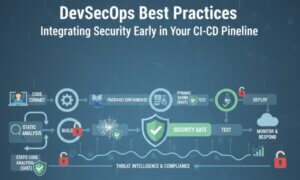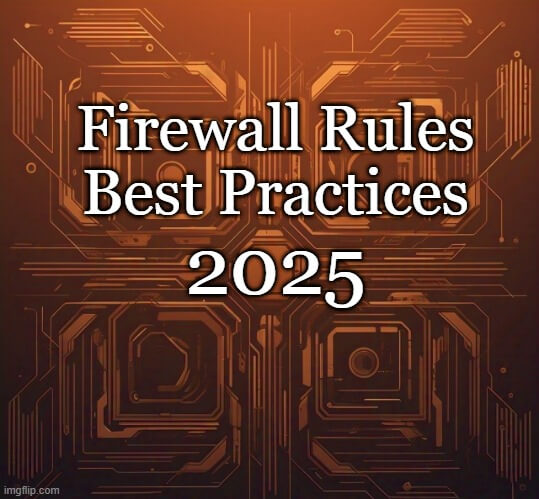Firewalls are the cornerstone of modern cybersecurity, acting as the first line of defense against cyber threats. However, an improperly configured firewall can leave networks vulnerable to attacks. With evolving threats and advanced attack techniques, businesses and IT professionals must follow best practices to ensure robust network security. This guide outlines the best practices for configuring firewall rules in 2025 to maximize security and performance.
1. Implement the Principle of Least Privilege (PoLP)
The Principle of Least Privilege (PoLP) dictates that users and applications should only have access to the minimum resources required to perform their tasks. Apply this principle to firewall rules by:
Blocking all traffic by default and allowing only necessary connections.
Restricting access to critical services and ports.
Limiting administrative access to firewall configurations.
2. Define and Categorize Firewall Rules Clearly
A well-structured firewall rule set is essential for effective management. Organize rules into categories such as:
Allow Rules – Explicitly allow essential services.
Deny Rules – Block unwanted traffic.
Logging Rules – Record suspicious activity for future analysis.
Temporary Rules – Set expiration dates for short-term access needs.
Proper documentation of firewall rules ensures that security teams can understand, audit, and modify them when necessary.
3. Follow a Layered Security Approach
Firewall rules should be part of a broader defense-in-depth strategy, which includes:
Perimeter Firewalls – Protect the outer boundaries of the network.
Internal Firewalls – Segment internal networks to contain threats.
Host-based Firewalls – Secure individual devices and endpoints.
By deploying multiple layers of firewalls, organizations can reduce the risk of lateral movement by attackers.
4. Regularly Audit and Update Firewall Rules
Firewall rules should not remain static. Regularly auditing and updating rules help eliminate outdated or redundant configurations. Best practices include:
Conducting periodic reviews (e.g., quarterly or biannually).
Removing obsolete rules that no longer serve a purpose.
Adjusting rules to align with changing business needs and emerging threats.
5. Prioritize Firewall Rule Order
Firewalls process rules sequentially from top to bottom. If an incorrect rule is placed before a critical rule, it may unintentionally allow or block traffic. To optimize rule processing:
Place specific allow rules before broader allow rules.
Position deny rules strategically to block malicious traffic efficiently.
Ensure logging rules capture all necessary events without performance overhead.
6. Utilize Stateful Inspection for Enhanced Security
Modern firewalls use stateful packet inspection (SPI) to track the state of active connections and allow only legitimate traffic. Benefits of SPI include:
Blocking unsolicited inbound connections while allowing responses.
Reducing the risk of spoofed or unauthorized traffic.
Enhancing security without degrading performance.
7. Restrict Administrative Access
Unauthorized modifications to firewall configurations can lead to severe security breaches. Best practices for securing administrative access include:
Using Multi-Factor Authentication (MFA) for firewall management.
Implementing Role-Based Access Control (RBAC) to limit access to trusted personnel.
Restricting remote access to firewall management interfaces.
8. Enable Logging and Monitoring
Firewall logs provide valuable insights into network activity and potential threats. Effective logging and monitoring practices include:
Enabling real-time alerts for suspicious activities.
Storing logs securely for forensic analysis.
Using a Security Information and Event Management (SIEM) system for centralized log management.
9. Protect Against DDoS and Advanced Threats
With the rise of Distributed Denial of Service (DDoS) attacks, firewalls must be configured to mitigate such threats. Effective measures include:
Rate-limiting connections to prevent abuse.
Blocking known malicious IP addresses using threat intelligence feeds.
Deploying Web Application Firewalls (WAFs) for application-layer protection.
10. Secure Cloud-Based Firewall Configurations
As more organizations migrate to the cloud, securing cloud-based firewalls is essential. Best practices for cloud firewall security include:
Using security groups and access control lists (ACLs) for cloud instances.
Ensuring encryption for data-in-transit and data-at-rest.
Implementing Zero Trust Architecture to verify every connection request.
Conclusion
Configuring firewall rules effectively is critical to maintaining a secure and resilient network. By implementing best practices such as applying the principle of least privilege, conducting regular audits, prioritizing rule order, enabling stateful inspection, and restricting administrative access, organizations can protect themselves against evolving cyber threats.
As cybercriminals continue to develop more sophisticated attack methods, staying proactive with firewall security will be key to safeguarding business networks in 2025 and beyond.
Why Businesses Trust SecureMyOrg For Comprehensive Network Security
At SecureMyOrg, we uncover and fix all possible security vulnerabilities of mobile and web, while providing solutions to mitigate risks. We are trusted by renowned companies like Yahoo, Gojek and Rippling, and with 100% client satisfaction, you’re in safe hands!







Some of the things people reach out to us for –
- Building their cybersecurity program from scratch – setting up cloud security using cost-effective tools, SIEM for alert monitoring, building policies for the company
- Vulnerability Assessment and Penetration Testing ( VAPT ) – We have certified professionals, with certifications like OSCP, CREST – CPSA & CRT, CKA and CKS
- DevSecOps consulting
- Red Teaming activity
- Regular security audits, before product release
- Full time security engineers.
Relevant Posts

How To Inspect Encrypted Traffic Without Breaking Privacy
Network administrators face a challenge: securing systems while respecting privacy. This guide explains how to inspect encrypted traffic without breaking privacy using metadata, anomaly detection, and machine learning ensuring visibility, compliance, and trust.

How to Audit Infrastructure as Code (IaC) for Security Vulnerabilities
Discover how to audit Infrastructure as Code (IaC) for security vulnerabilities with this practical guide. Learn to scan IaC files using tools like Checkov, fix issues like exposed resources, and integrate audits into CI/CD pipelines. Protect your cloud systems from misconfigurations and ensure compliance with clear, actionable steps.

DevSecOps Best Practices: Integrating Security Early in Your CI/CD Pipeline
This article provides a practical guide to embedding security into every stage of your CI/CD pipeline. Learn core DevSecOps best practices like SAST, DAST, dependency scanning, secrets management, and compliance automation to catch vulnerabilities early, foster a culture of shared ownership, and build a secure-by-design development process that accelerates release cycles.

5 Cloud Misconfigurations That Lead to Data Breaches
Cloud misconfigurations are one of the leading causes of data breaches, yet they’re also among the most preventable. From exposed storage buckets to weak IAM policies, attackers exploit these mistakes daily. Learn about the top 5 misconfigurations and how your organization can fix them before they lead to costly data exposure.

How Can Ethical Hacking Training Elevate Your Internal Cybersecurity?
Ethical hacking training empowers organizations to strengthen internal cybersecurity by uncovering vulnerabilities before attackers do. From mastering penetration testing to enhancing incident response, this training builds a proactive security culture. Learn how Secure My ORG’s programs can elevate your team’s skills and fortify defenses against modern threats like AI-driven attacks.

AI‑Generated Malware: Threat or Hype?
AI-generated malware uses advanced algorithms to create adaptive and hard-to-detect threats, posing serious challenges for modern cybersecurity defenses. Unlike traditional malware, it can evolve on its own, learning how to bypass security systems without human input. As a result, cybersecurity teams must increasingly rely on AI-driven tools and strategies to detect and neutralize these sophisticated digital attacks.

